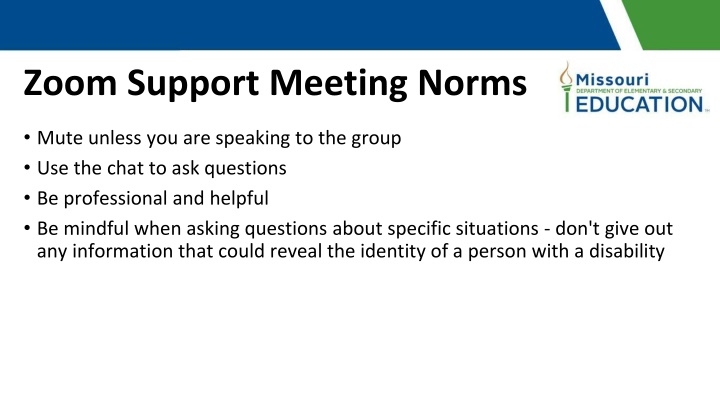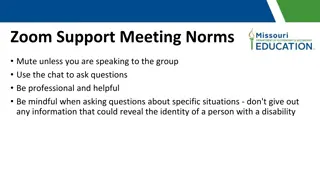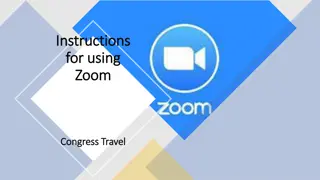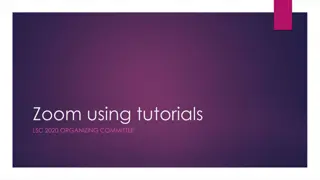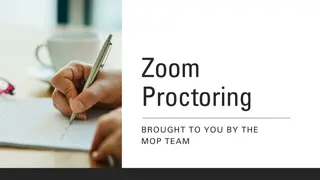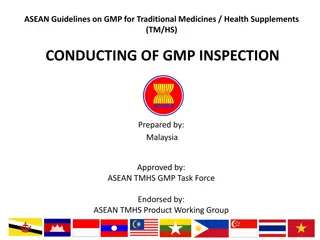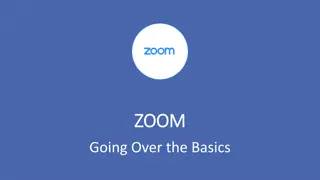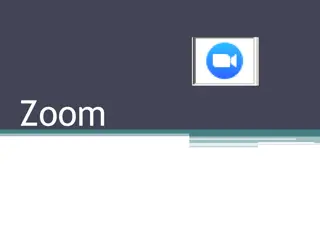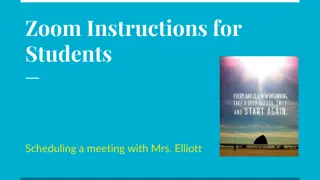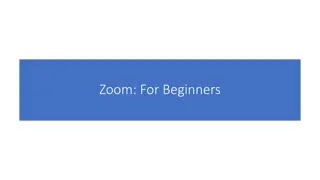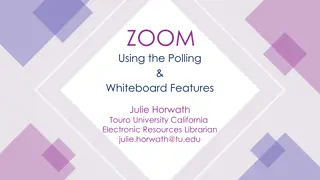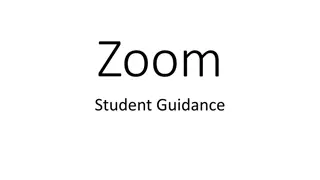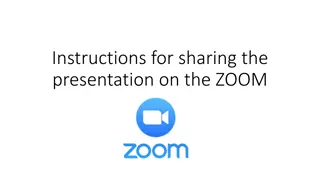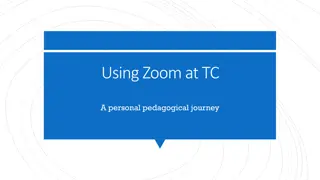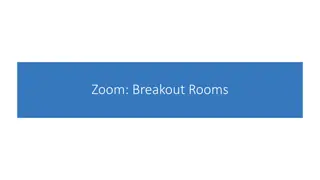Guidelines for Conducting Effective Zoom Support Meetings
Ensure a productive Zoom support meeting by muting when not speaking, using chat for questions, maintaining professionalism, and respecting privacy. Prioritize creating compliant present levels of academic and functional performance statements with a comprehensive evaluation. Engage the appropriate IEP team members and focus on the end goal of enabling student success through individualized education plans.
Download Presentation

Please find below an Image/Link to download the presentation.
The content on the website is provided AS IS for your information and personal use only. It may not be sold, licensed, or shared on other websites without obtaining consent from the author.If you encounter any issues during the download, it is possible that the publisher has removed the file from their server.
You are allowed to download the files provided on this website for personal or commercial use, subject to the condition that they are used lawfully. All files are the property of their respective owners.
The content on the website is provided AS IS for your information and personal use only. It may not be sold, licensed, or shared on other websites without obtaining consent from the author.
E N D
Presentation Transcript
Zoom Support Meeting Norms Mute unless you are speaking to the group Use the chat to ask questions Be professional and helpful Be mindful when asking questions about specific situations - don't give out any information that could reveal the identity of a person with a disability
Present Level of Academic and Functional Performance Tips for Creating Compliant Present Level of Academic and Functional Performance Statements February 2022
Terminology Present Level of Academic and Functional Performance statement is sometimes referred to as: PLAAFP Present level PL PLP PLEP Most common reference: PLAAFP
Before we Begin A Few Assumptions A comprehensive evaluation was conducted, eligibility was appropriately determined, and a compliant evaluation report was created A compliant PLAAFP can not be written from an evaluation report that does not meet compliance standards An appropriate IEP team is convened, and each team member is actively engaged in developing the IEP Required IEP team members, plus any others who have knowledge of student and could provide input to develop IEP, should create the IEP If the parent excuses a team member from attending the IEP meeting, get team member input prior to meeting The more team members who contribute to the development of the IEP, the more robust and comprehensive the student s IEP will become Team members should bring data to the IEP meeting to assist in drafting the IEP
Before We BeginA Few Assumptions Begin With The End in Mind . The end goal of developing an IEP: Ensure provision of FAPE to student Enable the student to acquire skills, through the provision of special education and related services designed to meet their unique needs; and prepare them for further education, employment and independent living skills. (34 CFR 300.1) If you don t know where you are going, any road will take you there. IEPs are the roadmap to student success. Pete Wright, Wrightslaw.com
Present Level of Academic and Functional Performance The What
Present Level of Academic and Functional Performance Sec. 300.320 (a) Statute/Regs Main Regulations Part B Subpart D Section 300.320 a (a) General. As used in this part, the term individualized education program or IEP means a written statement for each child with a disability that is developed, reviewed, and revised in a meeting in accordance with 300.320 through 300.324, and that must include (1) A statement of the child s present levels of academic achievement and functional performance, including (i) How the child s disability affects the child s involvement and progress in the general education curriculum (i.e., the same curriculum as for nondisabled children); or (ii) For preschool children, as appropriate, how the disability affects the child s participation in appropriate activities;
Present Level of Academic and Functional Performance Academic AND functional performance definitions Neither defined in IDEA but discussed in OSEP guidance and IDEA commentary Academic achievement: Academic achievement generally refers to a child s performance in academic areas (e.g., reading or language arts, math, science, and history). We believe the definition could vary depending on a child s circumstance or situation, and therefore, we do not believe a definition of academic achievement should be included in these regulations. (71 Fed. Reg. at 46662) The academic subjects a child studies in school and the skills the student is expected to master in each of the subjects such as reading and language arts, writing, math, science, history, and so on. https://www.parentcenterhub.org/present-levels/
Present Level of Academic and Functional Performance Sample snippets ** of academic performance Student has a current independent oral reading grade level of 2.0 and has a reading comprehension grade level of 1.5. Student can compute single digit addition facts with sums under 20 with 100% accuracy. Student s writing skills have improved this year. According to his teacher, he is currently able to consistently construct a 4-sentence paragraph that consists of a topic sentence, 2 detail sentences and a closing sentence, without teacher assistance or prompting. He consistently uses appropriate end punctuation in his independent writings. Student s most recent iReady reading assessment indicates he can identify all long and short vowel sounds when they are presented in nonsense words. ** Not complete PLAAFP statements
Present Level of Academic and Functional Performance Functional Performance: With respect to the meaning of functional performance, the Department of Education points to how the term is generally understood as referring to skills or activities that are not considered academic or related to a child s academic achievement. This term is often used in the context of routine activities of everyday living. The reason that examples of functional skills were not included in IDEA was because the range of functional skills is as varied as the individual needs of children with disabilities (71 Fed. Reg. at 46661). Routine activities of everyday living refers to skills and activities of daily living skills such as: dressing, eating, going to the bathroom; social skills such as making friends and communicating with others; behavior skills, such as knowing how to behave across a range of settings; and mobility skills, such as walking, getting around, going up and down stairs. https://www.parentcenterhub.org/present-levels/
Present Level of Academic and Functional Performance DESE IEP model form defines functional performance Functional performance refers to general ability and problem solving, attention and organization, communication, social skills, behavior, independent living, self-advocacy, learning style, vocational, employment Sample snippets ** that address functional performance Student s ability to solve problems in everyday life such as determining where to seek help when needed, how to dress appropriately for the weather and how to express wants and needs is limited in comparison to same age peers. Student learns grade level concepts best when presented with visual aides such as notes, graphic organizers and charts and graphs. He has difficulty retaining information presented auditorily. Student s limited attention to task makes it difficult for him to independently complete teacher assigned tasks. Student is kind, social and compassionate. Student has a large circle of close friends. She often initiates play with her peers during recess and enjoys going to the first-grade classroom to read to younger students. Student is nonverbal and when frustrated will often bite, scream or kick to express needs. **These are not complete PLAAFP statements
Present Level of Academic and Functional Performance Must address both academic and functional performance of student Must list areas of identified need and strengths Performance must be be described using: Language that is clear to all stakeholders Data Comparisons to grade level standards or to same age/grade peers Present level= describing the child s current functioning
Present Level of Academic and Functional Performance The Why
Evaluation Report: Eligibility Determination Data
Present Level of Academic and Functional Performance Why is it important? The PLAAFP is the bridge between information contained in the evaluation report and acts as the foundation for an IEP that provides FAPE to the student. The present levels statement is intended to comprehensively describe a child s abilities, performance, strengths, and needs. It is based on, and arises out of, all the information and data previously collected and known about the child, most especially the full and individual evaluation of the child that must be conducted in accordance with IDEA s evaluation/eligibility provisions of 300.301 through 300.311. A well-written present level will describe: the child s strengths and weaknesses, what helps the child learn, what limits or interferes with the child s learning, objective data from current evaluations of the child, and how the child s disability affects his or her ability to be involved and progress in the general curriculum. The PLAAFP drives the creation of appropriate IEP goals, services, supports and placement. Present Levels (Component of the IEP) | Center for Parent Information and Resources (parentcenterhub.org)
Present Level of Academic and Functional Performance: Caselaw Statement of Present Levels of Educational Performance The statement of present levels of academic performance essentially creates a baseline for designing educational programming and measuring future progress. Bakersfield City Sch. Dist., 51 IDELR 142 (SEA CA 2008). This section of the IEP that includes the child's PLAAFP must be all-encompassing so as to provide a baseline that reflects the entire range of the child's needs, including both academic (reading, math, communication, etc.), and nonacademic (daily life activities, mobility, etc.) areas. This statement should provide relevant background information about the child's areas of need, strengths, interests, and learning style. 34 CFR 300.324 (a). The statement of PLAAFP should be individualized and reflect the student's unique abilities. See Letter to New, 211 IDELR 464 (OSEP 1987). A statement of PLAAFP that is unclear or ambiguous could result in a denial of FAPE. In Clovis Unified School District, 109 LRP 69459 (SEA CA 10/19/09), the present levels of academic achievement and functional performance in a transfer student's existing IEP were too vague to be useful. SpecialEdConnections: SmartStart: IEP- Statement of Present Levels of Educational Performance
17 Endrew F: Finally, ED wrote that, so that the Endrew F. standard is met for each individual child with a disability, districts must implement policies, procedures, and practices related to: 1) identifying present levels of academic achievement and functional performance; 2) the setting of measurable annual goals, including academic and functional goals; and 3) how a child's progress toward meeting annual goals will be measured and reported. In Questions and Answers on Endrew F. v. Douglas County School District. Re-1, 71 IDELR 68 (EDU 2017)
Present Level of Academic and Functional Performance Cohort 1 file reviews PLAAFP indicators made the statewide Top 10 list of indicators called out of compliance Regionally, #1 indicator called out of compliance 39/80 files had one of the 200.740 indicators out of compliance 17/22 LEAs had one of the 200.740 indicators out of compliance Result of increased expectations for minimal compliance to ensure districts are meeting Endrew F standard of FAPE The Supreme Court determined that, to meet its substantive obligation under the IDEA, a school must offer an IEP [individualized education program] that is reasonably calculated to enable a child to make progress appropriate in light of the child s circumstances. The Court additionally emphasized the requirement that every child should have the chance to meet challenging objectives. https://sites.ed.gov/idea/files/qa-endrewcase-12-07-2017.pdf
2021 Top Ten Indicators Out of Compliance 1.200.810.b 92 student records, 64 LEAS: The IEP includes goals that are written in terms that are: Specific to a particular skill or behavior to be achieved, Measurable, Attainable (can reasonably be accomplished within the duration of the IEP), Results oriented, and Time-bound (generally happen within one year). 2.200.740.f 85 student records, 56 LEAs: A statement of the present levels of academic achievement and functional performance: Addresses the academic, developmental, and functional needs of the child. 3.200.810.a 80 student records, 56 LEAs: The IEP includes goals that demonstrate consistency with the content of the present level of performance. 4.200.180 75 student records, 23 LEAs: Eligibility staffing held within required timelines 5. 200.740.a 73 student records, 49 LEAs: A statement of the present levels of academic achievement and functional performance: Is consistent with evaluation/reevaluation results in the evaluation report. 6. 200.740.c 61 student records, 40 LEAs: A statement of the present levels of academic achievement and functional performance: Addresses how the child s disability affects her/his involvement and progress in the general education curriculum.
Present Level of Academic and Functional Performance A closer look at the PLAAFP related indicators 200.740 A statement of the present levels of academic achievement and functional performance The IEP includes a statement of the child s present level of academic achievement and functional performance that: 200.740.a Is consistent with evaluation/reevaluation results in the evaluation report. 200.740.b.Reflects changes in current functioning of the child since the initial/prior IEP. 200.740.c. Addresses how the child s disability affects her/his involvement and progress in the general education curriculum. (For preschool children, how the disability affects the child s participation in appropriate activities.) 200.740.d. Considers the results of the initial or most recent evaluation of the child. 200.740.e Addresses the strengths of the child and the concerns of the parent(s) for enhancing the education of their child. 200.740.f Addresses the academic, developmental, and functional needs of the child
Present Level of Academic and Functional Performance 200.740.a.Is consistent with evaluation/reevaluation results in the evaluation report** PLAAFP serves as a link to the evaluation report and eligibility determination Golden thread of relevant information should flow from the evaluation report to the PLAAFP Disability category stated in most recent evaluation report is same as stated in PLAAFP Adverse educational impact statements in evaluation report should align with needs stated in the PLAAFP and lay the foundation for describing how the child s disability impacts their involvement in the general education curriculum The PLAAFP should address all areas of adverse educational impact noted in the most current evaluation report Evaluation results summarized in PLAAFP must match the most current evaluation data **Your evaluation report could be the RED document if you conducted a reevaluation without assessment and eligibility category did not change
Present Level of Academic and Functional Performance 200.740.b.Reflects changes in current functioning of the child since the initial/prior IEP. Changes described using data comparisons from previous IEP cycle Include data from a variety of sources Progress monitoring data from previous IEP goals Classroom assessment data Teacher observations Parent reports State and district assessment data Behavioral data ( attendance, discipline data, Counselor reports) Health reports (updates from Dr reports, school health records, outside evaluations) This information provides baseline data for the formation of appropriate goals, services, and supports
Present Level of Academic and Functional Performance 200.740.c. Addresses how the child s disability affects her/his involvement and progress in the general education curriculum. (For preschool children, how the disability affects the child s participation in appropriate activities.) This is referred to as the impact statement Describes how the student s disability impacts their involvement and progress in general education curriculum Describe student skill levels in comparison to grade level standards and/or typical peer development Use specific examples to clearly paint the picture of how the student s disability impacts their involvement and progress in the general education curriculum. The information in this section needs to answer the question: How is the student s education being adversely impacted by their disability to the point they need specially designed instruction? Avoid just stating the what (student s disability category)
Present Level of Academic and Functional Performance 200.740.d. Considers the results of the initial or most recent evaluation of the child PLAAFP form requires a summary of initial or most recent evaluation results Summary must capture the highlights of the evaluation data No need to copy and paste entire evaluation report in the PLAAFP Summarize evaluation data that the IEP team needs to develop an appropriate IEP Include evaluation data and description of data s educational/instructional relevance in PLAAFP This data links the evaluation report findings to the PLAAFP and helps to drive the development of subsequent IEP components Evaluation data reported in PLAAFP must match data reported in initial or most recent evaluation
Present Level of Academic and Functional Performance 200.740.e .Addresses the strengths of the child and the concerns of the parent(s) for enhancing the education of their child. 2 Parts to this indicator Describe strengths of child Describe concerns of the parent for enhancing the education of their child Important to note student strengths as these can guide instruction and programming Parent input is critical to developing a compliant IEP Documentation of parent concerns in PLAAFP is one way to document parent engagement in IEP development process Ask open ended questions to acquire parent concerns Send home questionnaires or contact parents prior to meeting to gain information
Present Level of Academic and Functional Performance 200.740.f .Addresses the academic, developmental, and functional needs of the child Academic and functional needs must be addressed for every child Information in PLAAFP should paint a picture of the whole child not just a snapshot of academic performance
Present Level of Academic and Functional Performance The How
Present Level of Academic and Functional Performance Rubric
Present Level of Academic and Functional Performance Resources DESE PLAAFP Rubric https://dese.mo.gov/media/pdf/present-level-academic-and- functional-performance-rubric DESE Myth of the Month PLAAFP MOM coming soon https://dese.mo.gov/special- education/compliance/general-guidance IRIS Center PLAAFP Module: https://iris.peabody.vanderbilt.edu/module/iep01/cresource/q3/p06/ Parent Hub PLAAFP Information : https://www.parentcenterhub.org/present-levels/ LRP Special Ed Connection: Smart Start, Articles
